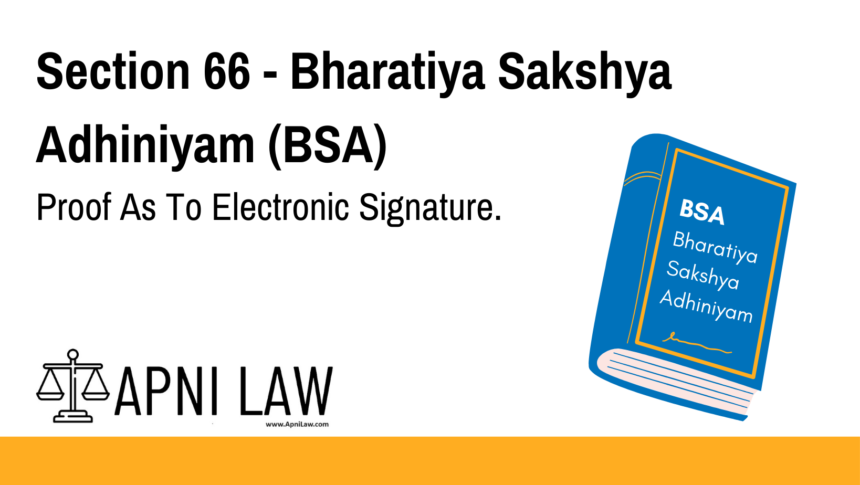Code: Section 66 – Bharatiya Sakshya Adhiniyam, 2023 (BSA)
Except in the case of a secure electronic signature, if the electronic signature of
any subscriber is alleged to have been affixed to an electronic record, the fact that such
electronic signature is the electronic signature of the subscriber must be proved.
Explanation of Section 66 BSA
Section 66 of the Bharatiya Sakshya Adhiniyam (BSA) outlines the evidentiary requirements for electronic signatures in legal proceedings.
It establishes that when an electronic signature is claimed to belong to a specific person (the “subscriber”), the person making that claim must prove its authenticity—unless it is a “secure electronic signature.” Secure electronic signatures are considered reliable and are presumed to be valid under the law.
This provision ensures that electronic records cannot be relied upon blindly unless verified, particularly in cases involving non-secure digital signatures.
Key Highlights:
-
Applies to all electronic records where electronic signatures are used.
-
Secure electronic signatures are presumed to be valid.
-
Non-secure electronic signatures must be proven in court.
-
The “subscriber” is the individual to whom the signature is attributed.
Illustration
Example 1: Standard Electronic Signature
A service contract is signed using a digital signature embedded in a PDF. If the signature is not a secure electronic signature, and one party disputes its authenticity, the burden is on the presenting party to prove that the signature belongs to the alleged signer.
Example 2: Secure Digital Signature
If the same contract was signed using a secure electronic signature issued and verified by a government-approved certifying authority, the court will presume the signature’s validity, and no further proof is required unless challenged.
Common Questions and Answers on Section 66 BSA
1. What is a secure electronic signature?
A secure electronic signature is created using secure methods and is backed by a digital certificate issued by a recognized certifying authority under the Information Technology Act, 2000.
2. Who bears the burden of proving an electronic signature?
If the signature is not secure, the person relying on the document must prove that the electronic signature belongs to the alleged subscriber.
3. Is a scanned image of a signature considered an electronic signature?
Yes, but it is not a secure electronic signature and therefore must be proven under Section 66 if its validity is contested.
4. What happens if the signature cannot be proven?
If the court is not satisfied that the electronic signature is genuine, the electronic record may be rejected as evidence.
5. How can someone prove the authenticity of an electronic signature?
Proof may be provided using digital certificates, metadata, server logs, expert testimony, or records from secure e-signature platforms.
Conclusion
Section 66 of the Bharatiya Sakshya Adhiniyam reinforces the importance of verifying electronic signatures used in digital documents. While secure electronic signatures enjoy a presumption of validity, other forms of signatures must be backed by evidence to be admitted in court. This provision plays a crucial role in ensuring that electronic evidence is both reliable and credible.
For more legal resources on the Bharatiya Sakshya Adhiniyam and digital law compliance, visit ApniLaw.








